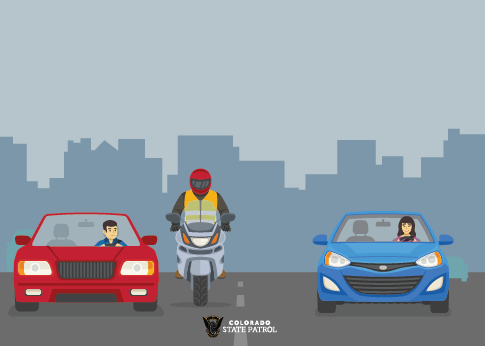Lane Filtering in Colorado
As of August 7, 2024, lane filtering is legal in the State of Colorado. Lane filtering is the act of a rider passing a vehicle in the same lane but only when that vehicle and any traffic in adjacent lanes are at a complete stop. This maneuver will likely be most common at stop lights or gridlocked traffic and will legally allow riders to navigate toward the front of the line, avoiding being sandwiched between two vehicles.

What is the Purpose of the Lane Filtering Law?
The new law allowing motorcyclists to filter in Colorado was designed to improve traffic flow and could save a motorcycle rider from injury or death. Lane filtering reduces the chance of a rider being rear-ended by a car or truck.
As part of this legislation, CDOT will compile a report and present the findings to the Colorado legislature by the beginning of 2027. The report will compare data from before and after the law's effective date and include information on motorcycle rear-end and side-swipe crashes. This law will automatically expire in September 2027, so the report can be reviewed, and lawmakers can determine what action, if any, should be taken.
With Rights Comes Responsibility
With motorcycles now legally practicing lane filtering, we've been asked who would be at fault if a lane filtering maneuver results in a crash. To answer that question, Colorado motorists and motorcycle riders should refer back to the law which explains the five rules of filtering in our state:
Lane Filtering is Legal in Colorado Under These Conditions
- To pass, traffic in the rider's lane and adjacent lanes going the same direction must be at a complete stop.
- The lane must be wide enough to fit the vehicle and motorcycle while passing.
- The motorcycle must go 15 mph or less.
- The rider must pass safely and control the motorcycle.
- The rider must pass on the left and not enter the oncoming traffic lane.
Lane filtering is not required; it is an option for riders. The law requires traffic going in the same direction as the rider should be at a complete stop. Therefore, if there is a crash, the rider would be at fault as they would be the only vehicle moving. It is up to the rider to assess every situation and determine if he can filter safely and legally before practicing the maneuver.
Understanding Lane Filtering
It is important to remember that lane filtering is legal, but lane splitting is not. Riders must ensure that there is enough room for them to pass on the left side of the vehicle while staying in the same lane. If the lane cannot accommodate both vehicles, the motorcyclist should not pass.
This law puts the rider in the position to assess each situation to determine if he/she can meet the legal requirements for safe filtering. The rider should not pass if they can’t follow the law or perform the maneuver safely. It is also the responsibility of every motorist to share the road. Drive with etiquette and with the law in mind. Respecting each other and driving without distractions will make everyone's commute faster and safer.
Whether you are a new motorcycle rider or someone with experience, the best way to enjoy the ride is to continually increase your knowledge and training. The Motorcycle Operator Safety Training (M.O.S.T.) offers three courses for every skill level.